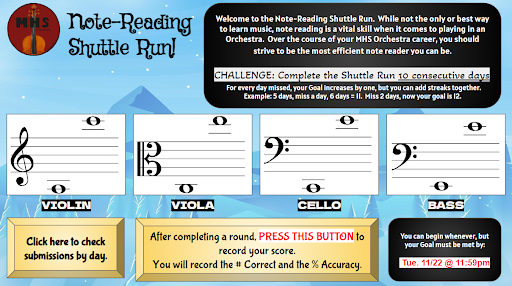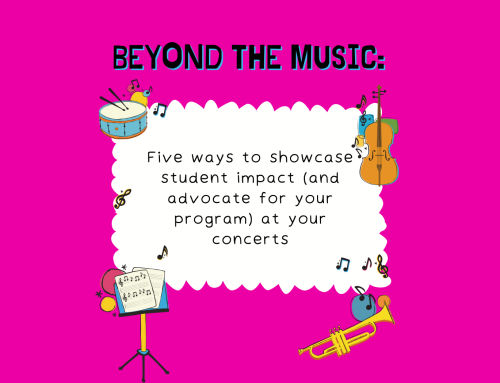I have spent my entire life in the seemingly unrelated worlds of Sports and Music. Thanks to High School Musical, the narrative that a teenager could live comfortably within the dual identities of Artist and Athlete in the mid-2000s was all but shattered. However, with the anthem of “We’re All in This Together” proudly being the wind beneath my wings, I emerged from the social rubble of this dilemma quite victorious. Now, as a music educator for 11 years and a varsity Cross Country coach for 10, I am in the unique situation where I can name both the five members of the Kutchka and the five members of the inaugural Baseball Hall of Fame Class in 1936. If that doesn’t win me some major money on Jeopardy someday…
Because I have spent equal time preparing for piano recitals and regional NCAA Cross Country races, I believe I have a unique position to speak to the ways these two universes can benefit each other. Whether I was practicing Grieg’s Piano Concerto in A Minor or running 2,000 meter repeats, the motivational factors, the reliance on data and statistics, and the importance of visualizing a positive outcome contributed to my success in both disciplines. My goal in this blog post is to mutually benefit both the music teacher and the coach. Both the Athlete and the Artist. Because at the end of the day, both have a lot to learn from the other.
Table of Contents
1- Grades do not motivate.
I have been playing or coaching organized sports since my parents signed me up for Maverick Little League Baseball (known around town as the “pitching machine” league) in 1st grade. When I graduated to the Mustang League (where kids started pitching) in 3rd grade and my team, the Rockies, won the championship, I was certain I was destined for the Major Leagues. When my baseball career ended in tragic style, getting cut from the Varsity Team as a Senior, I figured the Atlanta Braves probably wouldn’t be calling, so I switched to being a distance runner. This move ended up working out much better for me in the long run (pun intended).
In all of these athletic endeavors, I never once received a grade. No coach ever sent home a report card. I attended every practice and kept track of my own stats because I loved the sport and wanted to improve.
I don’t understand why the music classroom shouldn’t function the exact same way. I have yet to learn of a public school orchestra program that is not an elective class. I have also yet to learn of a music teacher that cited their “good grades in Band” as the reason they chose to pursue a music education degree. I certainly did not make my career choice based on the 100% I received in Orchestra for four straight years.
I stopped using the traditional grading scale in my classroom in 2019, the school year that ended in the Covid-19 pandemic. Covid confirmed my suspicions that student’s relationship to grades were toxic, and I have only veered farther away from the traditional grading method since. All that my students see in the grade book is a check mark in 5 categories (which we call our 5 Pillars): Daily Effort, Performance, Content Knowledge, Creativity, and Practice Habits. I have found absolutely no digression in the playing ability of my students since this change. In January of 2022, my top ensemble was selected to perform at the Illinois Music Educators Conference in Peoria, IL, an honor reserved for the top performing ensembles in the state. If this isn’t further evidence that grades shouldn’t be your motivating factor, I don’t know what is.
In 2020, my co-teacher, Pete Martin and I, gave a virtual clinic through IMEC called “Less Rehearsals, Better Concerts.” In this clinic, we talked about how our focus has shifted from a traditional Rehearse-Five-Days-A-Week culture to a more individualized, student-focused approach. You can access the slides from our clinic on the frontpage of our website.
2- Stats Don’t Lie.
We all know this isn’t true, especially given that 56.87% of statistics are made up on the spot. But stats are a great part of sports. Talking heads on ESPN love to compare athletes from different eras to see who, in fact, is on the Mt. Rushmore of NBA Point Guards Who Averaged 20 Points Per Game, 5 Rebounds Per Game, and only 2 Bathroom Breaks Per Quarter. Without stats, these conversations would just be people yelling at each other on TV. Wait…that’s what it is anyway. Bad argument. But at least stats can help strengthen the argument you are attempting to shout over the person who is shouting at you.
In music, we don’t have this same breadth of statistical analysis ready at our fingertips. So, we have to make it! And I have.
In Cross Country, it is very easy to compare athletes based on their times run on similar courses and similar days. In the Music Classroom, there are certain data points that can be used to gauge a student’s ability. In Quarter 2, I use an activity called the Note-Reading Shuttle Run to help track my student’s ability to read notes based on speed and accuracy. My students have to complete the “Shuttle Run” (a timed 60-second note-reading activity I made on musictheory.net) over 10 consecutive days and record their scores on a Google Form.

I stress that note-reading is not the only way to learn music, but in a public Orchestra setting, it is a vital skill that we want to improve. That is why the goal is not a certain number of notes, but rather the 10 consecutive days. Not every student will average 85 notes per minute (like my top student), but every student can discipline themself, much like an athlete going to the batting cages, to perform a repetitive task on a daily basis. To make the process more fun and visually appealing, I make a Google Sheet to automatically update and track who has completed the challenge, as well as to record the percentage increase from their lowest score to their highest score:

In Quarter 3, we do something similar with Sight Reading Factory where we focus on being able to audiate rhythms on the spot. Through my research in getting my Masters, I discovered that students are much quicker to identify pitches in sheet music than rhythm patterns. Through alternating difficulty levels and tempo, I drill each student until they “max out,” to borrow a weightlifting metaphor. These numbers are recorded and used to show student progression over their four years in my Orchestra.

While there is a big push in the Sports world right now to go all-in on Big Data and Analytics, just like in the Classroom, we shouldn’t identify students solely on a number they score. Data should inform a student’s progress, not determine it. I want my students to have a healthy relationship with the numbers I show them so that they can feel good about their progress, while also, like a runner striving to break a minute-mile barrier, they have a hard-and-fast goal after which to chase.
3- Performance Mindset
Musicians are performers. Nobody would argue with that statement. But we’re slower to throw that label on athletes. I would argue that there’s not that much difference. Musicians and athletes both spend hours and hours away from the public eye honing their craft and their skill. A wide receiver tip-toeing on the sideline takes an enormous amount of concentration and dexterity; so do Rachmaninoff piano concertos. A violinist must have complete control of their forearm, wrist, and fingers in order to execute an effective vibrato; I’d say Steph Curry has to do the same to average the mind-blowing shooting numbers he’s put up over his career.
However, no one sees this work. Or, at least, nobody before the internet (just check out LeBron James’s workout videos sometime if you want to feel bad about yourself).. Still, people don’t pay big bucks to watch trumpet players warm up on their chromatic scales.
I would often talk to my runners, especially before big postseason races, about the power of visualizing a performance. A positive mindset is so crucial to a successful performance. You have to trust the hours you have invested. You have to trust your muscles to perform their memorized function at the appropriate time. And, if you are a part of a large ensemble, you have to trust that your teammates will bring their best just as well.
Athletes like to use phrases like, “Get your game face on!” to show that your body and mind are aligned towards the goal at hand. Musicians have a similar phrase to this: “Break a leg!” Both phrases are designed to shake a person out of their average, mediocre mindset into an elevated, highly-driven state of mind. The audience has paid good money to see you at your highest level of excellence. Don’t let them down!
The pressure can be real, and we should never minimize the effects of this stress and anxiety on young minds. But we should also model what positive preparation should look like. I think it’s good and healthy to acknowledge the pressure before a big concert or a big game. But at the same time, our athletes and musicians need to hear us say that we trust them and have faith in their preparation.
One of my biggest inspirations as a coach and teacher is John Wooden, the legendary basketball coach at UCLA. The Wizard of Westwood, as he was called (and, by the way, how come only athletes get the cool nicknames???), was famous for this definition of success: “Success is peace of mind which is a direct result of self-satisfaction in knowing you did your best to become the best you are capable of becoming.” Win or lose, that should be something any musician or athlete can say at the end of the day.
4- The “Rudy” Soundtrack
If you want to know what the perfect marriage of music and athletics looks like, look no further than this amazing Jerry Goldsmith score written for the 1993 classic, “Rudy,” starring Samwise the Hobbit in the lead role and Vince Vaughn as someone that you forgot was in this movie until you see his name pop up on IMDB.
After first hearing the majestic main theme played behind a trailer for Spirit: Stallion of the Cimarron (shout out to this majorly underrated animated movie!), I downloaded the entire score on my iPod shuffle and would listen to all 42 minutes of it before every big race. Other fantastic sport-movie scores to check out are: Remember the Titans, Miracle, Rocky!, Angels in the Outfield, The Natural, and Chariots of Fire just to name a few.
The fact that America hired John William’s to write not one, not two, not three, but four concert works to commemorate the Olympics shows how much we believe music can enhance and capture the spirit of sports.
5- Show You Still Got It!
I know this might not be physically possible for many people, but I learned the most from coaches and conductors who weren’t afraid to show exactly what they wanted. Whether it was my first football coach getting down in a 3-point stance and hitting the blocking sled with the ferocity of a bear or a violin sectional coach sight-singing the passage in perfect solfeg, whenever my mentors would show their skills it added a little layer of inspiration to whatever they had just been preaching.
When I first began coaching in 2012, I was fresh off a knee scope surgery (the same one that ended my NCAA running career). While I longed to get out and run everyday with the team, I decided instead to show that pushing your body to its limits can be subjective, and daily discipline towards reaching a goal is a valuable life skill. Thus, I took up speed walking. My goal was to walk a 400 in 2:30. After several weeks of trying, I eventually succeeded…only to lose to a junior girl who beat me on her first try. Still, little by little, I worked my way back into running shape and completed a Half Marathon in 2019. Even if I couldn’t show my runners that I could hit the paces I was asking them to hit, I was showing them that I was committed to athletic excellence in my own way.
In the music classroom, I always want my students to see the great relationship I have with making music. Whether it’s writing goofy songs or raps to kick off the start of a school year or practicing the Bruch Violin Concerto whenever I was asking them to practice individually in class, I want my students to know that I still got it! If nothing else, they’re seeing an adult having fun working hard at their job, and I think that speaks volumes!
So, there you have it. Those are my quick takes on the benefits of a world where Music and Sports thrive in a symbiotic relationship. I know there may be pushback to several of these points, and I always welcome open and honest conversations about these sensitive issues. If you would like to get in touch, you can look me up me on Instagram (@davidgetzcreative) or on Twitter (@dave_getz). Also, feel free to check out my website, www.davidgetzcreative.com.




Leave A Comment